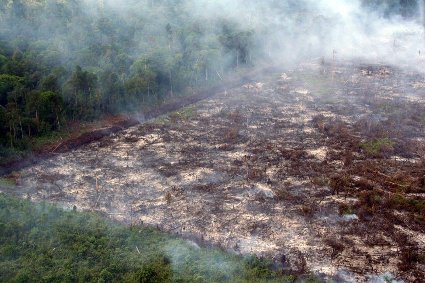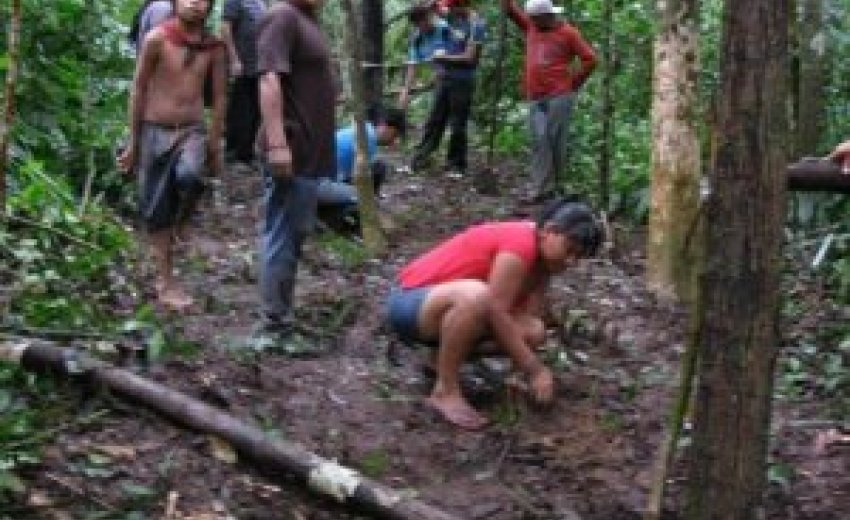How an Amazonian Tribe Is Mastering the Modern World
Part 4: Forest Could Vanish by 2100
 |
| Amazon Basin contains 40 percent of the world's tropical rainforests. DPA |
The Surui therefore commissioned a simulation of what would happen if they didn't protect their reservation: The "business as usual scenario", to use the REDD jargon. For the Surui, business as usual would mean that 30 percent of their forest would disappear in the space of 50 years. By the end of the century it could all be gone.
Swinging in his hammock gnawing on a peccary rib, Almir Surui throws out a huge figure: $120 million. That's the price of protecting his forests for 44 years and thus preventing 16,475,469 tons of carbon dioxide entering the atmosphere. The possible purchasers of such "credits" are companies willing to voluntarily trade in emissions, but also investment banks, brokers, and even governments. The US state of California would be one such candidate because it has pledged to reduce its CO2 output.
 |
| Juliane von Mittelstaedt
/ DER SPIEGEL Almir estimates -will cost $120 million to protect forests for 44 years. |
The Indio chief is well aware of the criticism of REDD. Critics say it is too complicated, that Mother Nature should not be steered by the logic of the money markets, that too much money is lost in transaction fees. Moreover it is far from certain that REDD will really help protect the environment.
Nevertheless if everything goes to plan, REDD could restore some of the indigenous peoples of Brazil's lost pride and make the world take them seriously. The Surui could become a model for how Amerindians could live off and in harmony with their forest.
Surui Business Plan
The Surui want to use a part of the money to build new homes for themselves and to plant even more trees. The would also like a hospital, a better school, computers for all, and pensions for the elderly and infirm; a mini welfare state for the Surui. The rest of the millions they hope to generate from emissions trading would be put into a fund with which they would buy companies and bring jobs to the region, something which would also benefit their enemies, the wood poachers.
The chief speaks of a business plan, about Surui coffee, yield, and growing capital assets. He talks just like a businessman -- which is exactly what he will be in the near future. He and other Surui are to act as the fund's supervisory board, a body he will chair. Fifteen Surui are currently studying business, biology, and tourism so that they can run the businesses.
The young people hope that emissions trading will bring the future into their village. The elderly hope it will bring tradition back to the village.
Almir senses it will be a delicate balancing act. He has turned the Surui into high-tech Indios, but at the same time he wants them to preserve their culture. He says he sometimes despairs, and worries that the two are mutually exclusive. "But what's the alternative?" He shrugs his shoulders. There is none.
Rainforest in the Desert?
That evening, the old world and the new can be witnessed side-by-side in the village. A thick curtain of rain is falling. In one of the huts, a laptop sits on a chair. It is showing a video filmed during the Mapimai festival, the celebration of the creation of the world. The festivities feature a contest between two clans. They paint themselves, don decorative feathers, and then see who can drink the most chicha, a beer brewed from maize. On screen, men stagger around, laugh, sway together, and vomit. The children of the village sit in front of the laptop laughing. Next up is a video of Almir giving his speech at the Copenhagen Summit.
The chief sits next to them, lost in thought. Memories of Copenhagen are long gone. He's already hatching his next plan. A company from Abu Dhabi in the United Arab Emirates has called him and asked whether it would be possible to grow a rainforest in the middle of the desert. Almir knows Abu Dhabi is a country made of sand. But along the Persian Gulf they've already built the world's tallest building, an island shaped like a palm tree, and a ski slope. So why not a rainforest?
Almir told the sheikhs he would need $15 million -- and of course a hall surrounding the forest -- to complete the project. The Surui would manage the undertaking, and money earned from entrance fees would be used to buy back the land surrounding their reservation, land that used to belong to them.
Almir Surui smiles. Thirteen years into his 50-year plan, he's certainly not running out of ideas. In fact, he's only just hitting his stride.
Translated from the German by Jan Liebelt
* Part 1: How an Amazonian Tribe Is Mastering the Modern World
* Part 2: Two Worlds
* Part 3: 'An Email from the Heart of the Rainforest'
* Part 4: Forest Could Vanish by 2100

